Today, I want to share with you an exquisite piece of whitework embroidery which, at first glance, could be mistaken for a pristinely preserved antique.
But it’s not! No, indeed, this is a brand new piece of embroidery, worked by Jacqueline Barcelo, a Needle ‘n Thread reader, as a gift for her daughter.
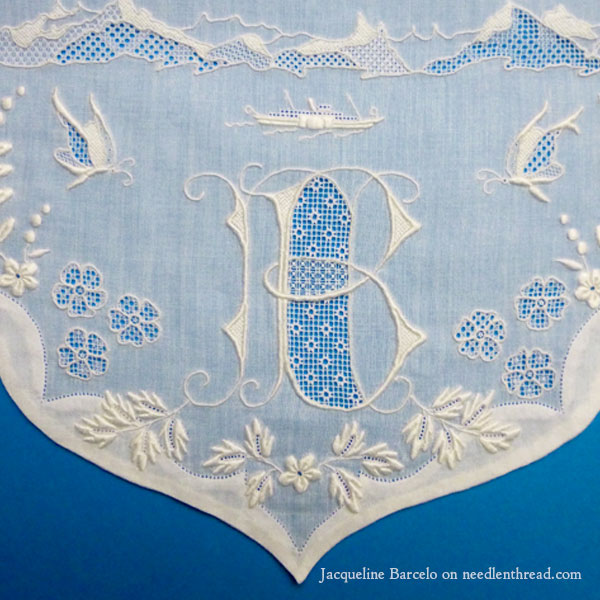
Remember: you can click on the photo for a larger version! And this piece is definitely worth the extra click!
Jacqueline designed this piece herself. It’s a pouch (or case) for a nightdress, worked on very fine muslin.
In the US, we think of muslin as a quilter’s cotton, opaque and sturdy (elsewhere, referred to as “calico”), but muslin can also be a very fine, sheer cloth.
Fine muslin was first imported into Europe from India as early as the 17th century. By the late 1700’s, weavers in Glasgow were attempting to reproduce the fine cotton cloth closer to home. During the Regency period of the early 1800’s, muslin was favored for its light, gauzy, airy elegance, and often embellished with embroidery. Muslin, with its soft drape, suited the revival of classical styles in clothing. Think: Jane Austen styles.
So this particular piece, embroidered on muslin, is not embroidered on quilter’s cotton, but rather a fine, sheer cotton, similar to a batiste or cambric.
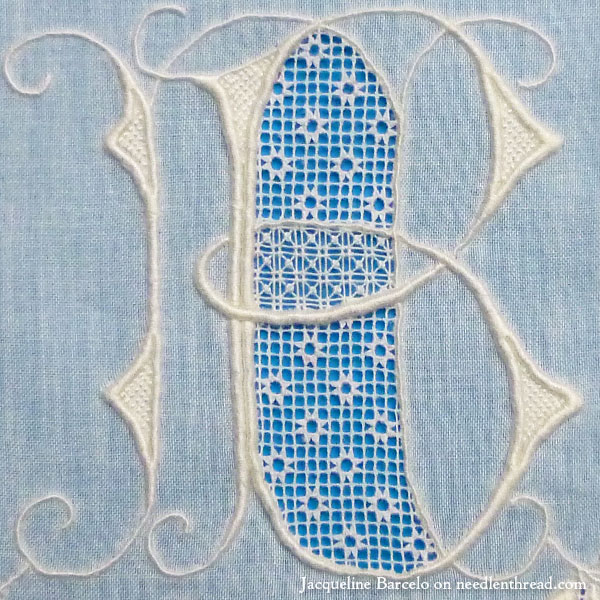
The embroidered case, which is shaped similar to an envelope, with the embroidery being on the flap, features a delicate monogram worked in trailing (satin stitch over string padding), with seed stitch in the dense parts of the letters and light, fine needle lace in the center of the letters.
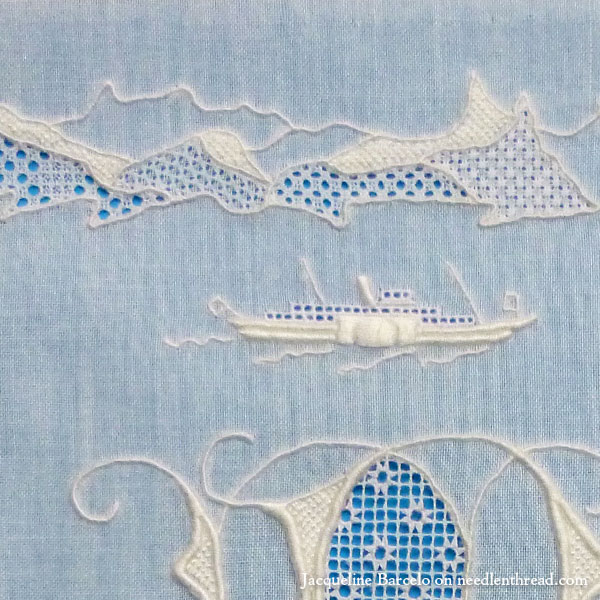
Little motifs in whitework and needlelace further embellish the piece. The mountains in the background are worked with various needlelace fillings, and a small boat floats neatly above the center monogram.
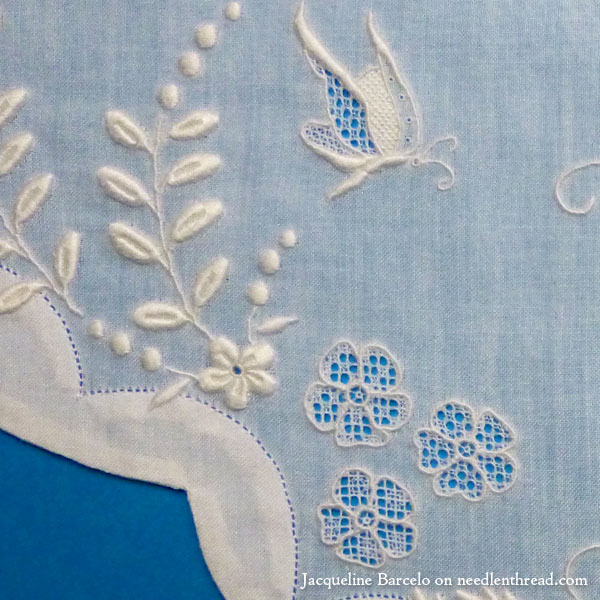
Butterflies and flowers abound, too, also worked in satin stitch, seed stitch, and various needlelace fillings.
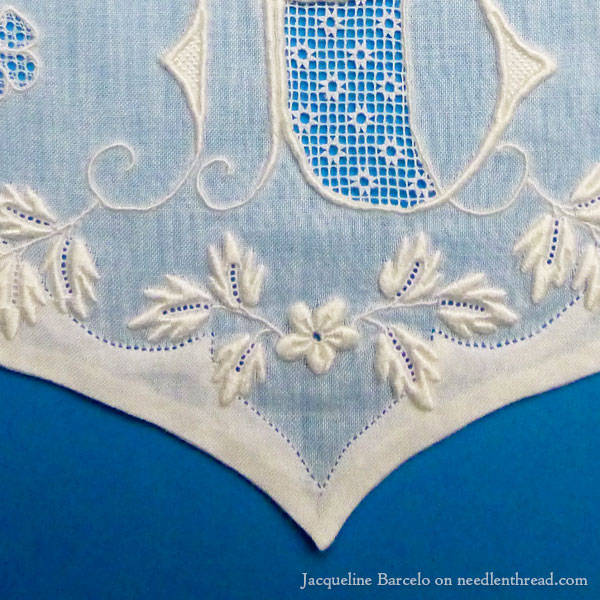
The edge is worked in a lovely Madeira appliqué style, with pin stitching.
And it’s All Done By Hand!
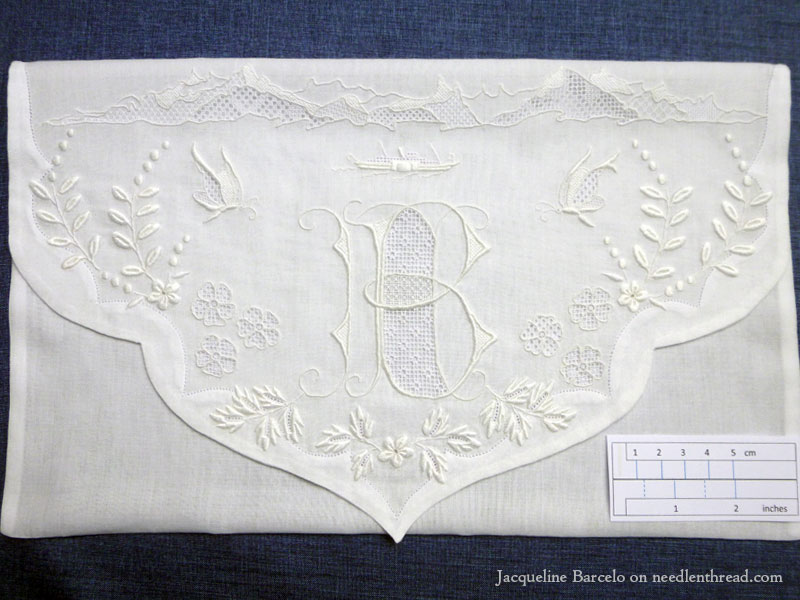
One of the reasons we don’t see this type of whitework done today – besides the incredible amount of time and skill involved – is the fact that the supplies used for this type of embroidery are fairly rare. In fact, the threads used for the embroidered parts (the satin stitching and seed stitching) are no longer manufactured.
Jacqueline used old DMC coton a broder in sizes 40 and 60 for the satin stitching. Even as recently as 7 years ago, coton a broder #40 was still available, but it’s no longer being made now. Coton a broder #60 disappeared long before that.
For the needlelace, Jacqueline used very fine threads used for bobbin lace: 100/2 and 185/2. Here in the States, cotton lace making threads up to 170/2 are pretty easy to find (search for lace-making suppliers), but the finer 185/2 is harder to come by (Lacis.com carries it).
I hope this piece inspires you as much as it does me! It’s always heartening to know that this type of exquisite whitework is still being accomplished.
Well done, Jacqueline!
Like what you see?
If you enjoyed this article and you’re looking for more inspiration, information, and instruction on hand embroidery, why not sign up for my daily newsletter?
There are all kinds of reasons to have Needle ’n Thread delivered to your inbox – check them out and sign up today!







That is absolutely stunning! I have no other words for it.
Good morning Mary,
how sad that the supplies to make such a wonderful piece are not produced anymore! The knowledge of making such beautiful items will slowly disappear not because of lack of interest, but lack of supplies.
Still thank you for providing us with this gorgeous piece of embroidery.
Just a tit bit, in the Southern part of Europe, muslin is fine, transparent cotton, batiste is usually fine cotton, but not as transparent, more for handkerchiefs, fine men’s shirts. Calico is referred to cotton with small square prints.
Regards,
Jackie
Uh oh! True batiste is made of linen. Available in France from La Couserie Créative. Quite pricey.
A fine transparent linen is named Bisso by Italians. Available from Canetta.
Dear Mary
This is an exquisite piece of embroidery I love needlelace and would love to try it it’s deliciously beautiful. My favourite part of the embroidery piece is the butterfly, I love butterflies and with the needlelace and satin stitch it’s really stunning. The monogram is also beautifully embroidered and the centre needlelace really sets off the whole piece. What a wonderful gift for her daughter. Well done Jacqueline it must have taken a long time to embroider your daughter should be really pleased with the piece. Thanks Mary for sharing such a beautiful piece of embroidery I wish I could accomplish something so stunning.
Regards Anita Simmance
Exquisite!
Hello Marie,
Juste magnifique, impressionnant de délicatesse et une réalisation comme on n’en voit plus, beaucoup aimé la conception du tableau. Grande admiration pour vous Jacqueline.
WOW!! This is the most exquisite piece of whitework I’ve ever seen! What a fabulous gift; you have created an heirloom that I trust will be cherished for generations!
“Exquisite” truly is the only word for this — it takes my breath away.
Jacqueline’s daughter is a very, very lucky girl!
Amazing work. Beautifully done, Jacqueline! I admire your fabulous skill as an embroiderer.
Hi Mary,
This pieces makes me so happy and yet sad. Jacqueline did an amazing piece of art work. It makes me happy to see this type of high level stitchery still being created for others to enjoy. However, as a newbie to embroidery it makes me sad and nostalgic for the type of threads we no longer have privy too.
Barbara
I am not that much of a newbie since I’ve been doing counted cross-stitch for years but I am new to the type of surface embroidery Mary does. I just finished a large panel from the Bayeux Tapestry using Bayeux stitch in wools and that was a totally new experience for me. I love looking at what Jacqueline has created and it makes me not sad exactly but maybe wistful that I will never have that level of skill. It makes me happy though that there are still people like Jacqueline and Mary making the world more beautiful with their lovely artwork.
Stunning. Absolutely, stunning. Love, love, love!
Does Jacqueline have a website?
That is absolutely beautiful!
Hello Lisa
I have no website : it is time consuming and I prefer embroidery … Thank you for your interest.
Thank you so much for showing this great piece of white work embroidery! And well done to Jacqueline. Early September, I will go to Appenzell to have a workshop with one of the last teachers of this fine white work technique. One thing I am particularly curious about is how they get their hands on the materials. i’ve got a suspicion that it is mainly old threads they use. I will let you know all about it. However, wouldn’t it be great if you could join us? Have a nice weekend! Jessica
Hi Jessica, Please do keep us informed of your trip. It is amazing whitework. Lucky you! I hope the threads for Appenzell are still available. The loss of cotton a broader 40 and 60 is so disappointing when you can see the quality of work that can be produced when embroiderers have the appropriate threads to use.
Hello Jessica
It is a very good idea to go learning in Appenzell. They do a fantastic embroidery, since many years. And then you must practice what you learned, day after day, doing new exercises, and you will see your skills growing better and better. For models, you can take them for old books (see Antique Pattern Library, and others from the websites recommanded by Mary), and follow the very good advices she gives ; then, be imaginative, and do what you like ! Pleasure is the best guide !
Thank you for your comments.
Absolutely beautiful! When I think of the ridiculous sums of money paid for some daubs of paint on a canvas and called ‘art’, I can only rejoice that there are some true artists around like Jacqueline. Her work is of far greater value.
Breathtakingly beautiful. Thank you for sharing it.
Irresistible. Seeing the ship made me think how I could commemorate my recent cruise with a wee glimpse of highlights of the trip and vessel. I frequently think that I should add more Madeira applique pin stitching to a project I design. Maybe like people who teach beginners tatting with huge diameter cords, I will be inspired to use Floche and refer to this gorgeous inspiration to hand stitch something in cooler weather.
Exquisite, indeed! I am in awe of the skill and patience this piece took. What a beautiful gift!
I was so excited to read this article. A friend just gifted me a nice bunch of linens, including a piece that looks like this. I couldn’t figure out the fabric and now believe it is this fine muslin. Thanks Mary!
Breathtaking!!!! What an heirloom to be passed down throughout the ages to come. I hope she slips a small note inside that describes who made it, why and a few descriptions of the techniques used.
The openwork appears to be drawn thread work rather than needlelace. An absolutely stunning piece of work in any case. I wonder what the significance of the boat is?
Hello Nays
Yes, you are right. There is a lot of drawn threads work, and pulled threads work, and also needle lace work.
The boat is an old boat of the Leman Lake, near Geneve (Switzerland).
Thank you for your comment.
I would love to have someone living nearby to teach me how to do this so I could pass the techniques along. Not too many people want to learn hand work because it’s so time consuming but there are a few gems out there willing to learn it, just waiting….It’s nice to read on how to do things but it’s extra special to sit down next to someone very knowledgeable and learn from them.
I agree. Ottawa had a needlework shop for many years but it went under and now we have nowhere to go other than the big box craft store. They used to offer courses on cutwork and Hardanger, which I never took but was thinking about it. Now, I have to order all my supplies by mail and if I want to take a course, I have the expense of travel and hotels to consider as well as the cost of the course.
Jacqueline’s daughter is very lucky indeed!
That fine, light fabric is still called muslin in the UK.
Thank you so much Jacqueline and Mary for sharing this with us. It is truly exquisite! So sad, too, that lack of threads will deny future skilled embroiderers the chance to create something as lovely. It makes Jacqueline’s work all the more precious.
What a beautiful piece! I always thought of muslin as the heavier fabric, but reading this article calls to mind a line from Pride and Prejudice (I believe it’s from Lydia Bennett’s letter just before she eloped with Wickham, but wouldn’t swear to it) about a great slit in a worked muslin gown. Probably this fine, light material, not the heavier stuff I was picturing. Always fun to learn something new.
Wow, just wow. That is the daintiest, most exquisite white work I have ever seen. Jacquelin, you are a gifted and masterful designer and needle woman.
Admiringly
Joan
What a beautiful gift, gorgeous work.
I have a question:
If the threads to create such lovely pieces are not made or being discontinued, what can be used instead?
I’ve always wanted to learn this but am a little confused where to get supplies now.
Hello Janet
You can use just one strand of “coton mouliné” (DMC floss for example) or use egyptian cotton for bobbin lace (try to use 40/3 or 30/2 or 40/2 or 50/2) ; the first is the thicker. Unless you can use “coton à broder” number 25 (in the colour that you prefer !) and twist it (while you are embroidering) to get it thiner ; it makes some knots, so you have to pay attention to your work, but it works well ! Try it !
If you are using a good linen, you can use this coton without twisting. Mary tells us about “floche”: I think it will be good ; in France, it is hard to find, and I have only some skeins of very old white ones. So I cannot tell you much more. Perhaps Mary has an idea about it ?
Thank you for your interest. TRY and TRY again … and have fun and pleasure with your embroidery !
An incredibly beautiful piece! Thank you for sharing it (Jacqueline and Mary).
So, so beautiful, Jacqueline! I love the variety of drawn thread fillings. It’s really good to know that such fine whitework is still being done.
Thank you everybody for your interest.
I am afraid my english is not perfect, but I want to thank you for your congratulations. I am very pleased to share this with you, and to tell you : TRY ! Take a good old book and TRY ! With a piece of linen or cotton, and one thread of cotton floss if you have nothing else, and TRY ! Try again, do your best, and you will do better and better !
And thank you Mary for all your good advices.
Have a nice WE.
I make bobbin lace. You can find supplies at: snowgoose.com or vansciverbobbinlace.com. Lots of threads to choose from including linen threads. Hope this helps!
Barabal
I took up bobbin lace for awhile about 10 years ago and really enjoyed it but I found that while I was doing it, I couldn’t do anything else, like watch TV, which I can do when I’m stitching. Well, I can watch it more than I can when I was moving the bobbins around in whatever pattern. I was trying to learn leaves when I gave up. It was much too labour intensive for me. But I did love the technique and was glad I gave it a try.
Dear Jacqueline,
I so much enjoyed seeing your beautiful work – I have pored over the details. Mary’s photos are very good, especially since they can be so easily enlarged.
Thank you and Mary for sharing this.
Regards,
Helen Hicks
Thank you for sharing this exquisite heirloom-to-be.
I’m not curious about the differences between fine muslin, batiste and cambric, the latter a term with which I am unfamiliar.
Ooops! The above comment should read “I’m curious about…”
How stunning — gorgeous — amazing — a work of art!!! Look at what a needle ‘n thread can do!!! Thank you SO much for (a) doing it and (b) sharing it. Wonderful inspiration. And you are so right — (although it is sad that those materials are no longer available) — one must try and try and keep trying and just see what CAN be achieved.
Jacqueline, I agree, exquisite is the best word to describe this breath-taking work, and even that seems inadequate!! I have a ‘technical’ question … do you use a frame or hoop when you work, or do you work in hand? Such skilled work you do!!! Laura N
Hello Laura.
When I do this kind of embroidery, I must use a hoop ; I have about 15 wooden hoops, those with 2 circles that matches, and à brass screw. I have 3 with a diameter of 10 cm (4 inches), 3 for 12 cm, and some others larger, and one that I attach to the table (22 cm). Every hoop is carefully wound with cotton strip (the 2 circles), to avoid the fabric slipping, and to protect my work, and I change this strip when it is dirty. When I do embroidery, I usally use the very small, because I have small hands, and my fingers often have to cross in the middle of the hoop. When I do a larger part of drawn tread work, I take another more appropriate, the one on the table is for getting my two hands free.
Thank you for your interest.
what a heirloom piece!
I’m in utter admiration for Jacqueline’s skills. bravissima!
I love this type of whitework, often see on wedding handkerchieves for the bride. I have a special fondness for the split satin stitch seen on leaves and at the base of petals. It is so precisely done, it’s a wnder!
It was interesting to see the english names of some stitches I knew only in French.
For those interesting, I’ll translate
– satin stitch = plumetis
– trailing stitch = point de cordonnet
– pin stitching = point de Paris.
My goodness me – what a treasure! I am quite in awe of Jacqueline Barcelo!
This is truly a work of art! It’s absolutely beautiful. Congratulations, Jacqueline!
Thank you for showcasing Jacqueline Barcelo’s wonderfully worked case. The label “exquisite” is perfect because it is beyond beautiful. In addition to all the needle skills exhibited, I think the composition of the design–the scallops, the floral close-ups and the ship and snowy mountains in the far distance–masterfully frames the initial. The satin stitching is lustrous.
Stunning! A gift to treasure.